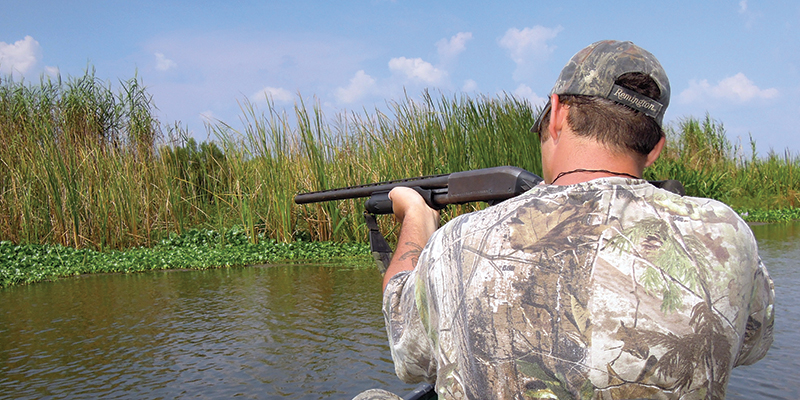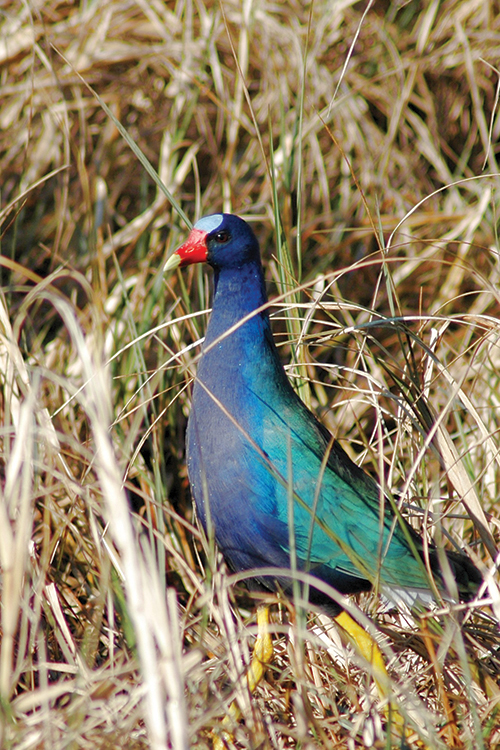
Photo by John N. Felsher
Often-ignored game birds provide fast action
“Shoot,” I yelled as birds exploded in all directions from thick reeds just a few feet from us. “There’s another one. Fire! Here comes a straggler. Get him!”
In seconds, my son pumped out three rounds from his 20-gauge shotgun, scoring a double. More birds flushed from the dense cover of the Mobile-Tensaw Delta marshes while others raced into the canes to escape as Daniel quickly tried to reload. Hastily dropping one shell into the chamber, he downed another bird struggling to get airborne.
Fortunately, the birds that were flushed didn’t travel far. We watched where most were headed, picked up our game and took a brief break. Minutes later, after the initial adrenaline rush, we found them again for another round. Repeating this procedure during the next two hours, Daniel fired a box of shells before bagging his limit.
Alabama sportsmen can target abundant game birds that frequently go unnoticed by others, but provide incredible action. Common and purple gallinules both bear a resemblance to coots. One of the most striking North American game birds, purple gallinules exhibit blue and green body feathers, purple heads, long yellow legs, white rumps and red bills with yellow tips. Bright blue forehead patches distinguish purple gallinules from their more drab red-patched cousins.
People can also bag king rails, the largest of the rail species. Sora rails almost look like quail with short, powerful bills. Gallinules and these rail species typically prefer freshwater systems with abundant thick vegetation growing in or near the water edge or matted on the surface.
Alone among the rails, clappers like salty marshes. Also called marsh hens, clappers look like skinny chickens with long bills. They often walk mudflats in coastal marshes looking to snatch invertebrates to eat. People often hear their clack, clack, clack calling.
Rail and gallinule seasons generally run concurrent with duck season, but sportsmen can get an early jump on these birds during the September teal season. Some people hunt teal at first light and then go looking for rails and gallinules later in the morning. A limit of gallinules can turn a humdrum teal hunt into an exciting adventure, especially for young children or novice sportsmen.
Most hunting done from boats

Since rails and gallinules do not respond to decoys or calls, sportsmen must go looking for them. Because soft mud in places like the Mobile-Tensaw Delta can make walking the marshes difficult, most people hunt them from small boats. Federal law prohibits shooting at migratory birds like rails and gallinules from boats under power, but sportsmen can paddle, drift or pole through the marshes or along a lake shoreline to hunt them.
Some people hunt alone, paddling canoes or other craft with their shotguns ready in a safe, convenient place, but sportsmen can hunt more effectively in teams. One person in the bow keeps a gun ready while the other person paddles, positions the boat and acts as spotter.
Paddling up rails and gallinules makes a great way to introduce children to hunting. They don’t have to sit long hours in a deer stand keeping quiet. They might see many birds in a good area so enjoy great action. In addition, hunters can easily carry snacks and refreshments in an ice chest and take occasional breaks if they wish.
Look for these birds along shorelines of sloughs and small channels with abundant matted vegetation and tall reeds that provide significant cover. At low tide, scan exposed mudbanks and grassy edges. At high tide, scrutinize any tall canes. Unlike loner rails, gallinules sometimes congregate in flocks in shallow coves with patches of matted aquatic grass. With their long toes, gallinules nimbly walk over floating lily pads, water hyacinths or other vegetation.
Rails and gallinules can fly and swim, but prefer to run into thick weeds to escape their enemies. When they do flush, they seldom fly far, usually dropping into a nearby clump of dense canes to hide. Hunters can frequently relocate them rather quickly.
The marshes of the Mobile-Tensaw Delta near Mobile probably offer the best opportunities to hunt rails and gallinules in Alabama, but people can also hunt many reedy lake or river shorelines throughout the state. Just about any freshwater system with tall reeds might hold gallinules.
 John N. Felsher is a freelance writer and photographer who writes from Semmes, Ala. Contact him through his website at www.JohnNFelsher.com
John N. Felsher is a freelance writer and photographer who writes from Semmes, Ala. Contact him through his website at www.JohnNFelsher.com




